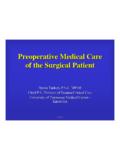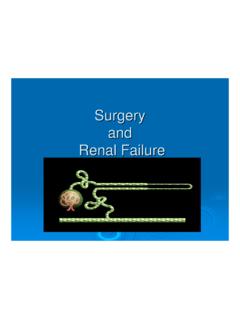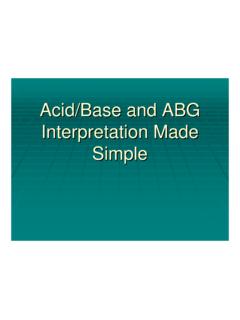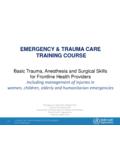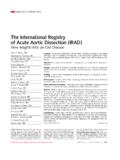Transcription of ACUTE ARTERIAL OCCLUSION - Medical Residency …
1 ACUTE ARTERIAL OCCLUSIONV ascular Surgery ConferenceMichael Lebow, MDACUTE ARTERIAL OCCLUSION The operation was a success but the patient died High Morbidity and Mortality Emergent operations in high risk patients 20% mortality reported (Dale, JVS 1984) Endovascular approaches may lower peri-procedural mortality while preserving outcomesEtiology of ARTERIAL OCCLUSION Overview Atherosclerosis Thromboticocclusion Embolic OCCLUSION Treatment OptionsEvolution of Atherosclerosis Areas of low wall shear stress Increased endothelial permeability Sub-endothelial lipid and macrophage accumulation Foam cells Formation of Fatty Streak Fibrin deposition and stabilizing fibrous capEvolution of Atherosclerosis Necrosis Inflammatory environment Destabilization of fibriouscapEvolution of AtherosclerosisRupture of Fibrous Cap Pro-thromboticcore Exposed to lumen ACUTE thrombosis Embolizationof plaque materials and thrombusThromboembolism Embolus-greek
2 Embolos means projectile Mortality of 10-25% Mean age increasing 70 years Rhumaticdisease to atherosclerotic disease Classified by size or content Macroemboliand microemboli Thrombus, fibrinoplateletclumps, cholesterol Macroemboli Cardiac Emboli Heart source 80-90% of thrombus macroemboli MI, , Mitralvalve, Valvularprosthesis Multiple emboli 10% cases TEE Views left atrialappendage, valves, aortic root not highly sensitiveThromboembolism 75% of emboli involveaxial limb vasculature Femoral and Polilteal >50% of emboli Branch sites Areas of stenosisThromboembolismNon-cardiac sources Aneurysmal(popliteal> abdominal) Paradoxical Follows PE with PFO TOS Cryptogenic 5-10% Atheroemboli(artery to artery)AtheromatousEmbolization Shaggy Aorta Thoracic or abdominal Spontaneous Iatrogenic 45% of all atheroemboli Blue toe syndrome Sudden Painful cyanotic palpable pulses livedoreticularisAtheromatousEmbolizatio n Risk factors: PVD, HTN, elderly, CAD, recent ARTERIAL manipulation Emboli consist of thrombus, platelet fibrin material or cholesterol crystals Lodge in arteries 100 200 micron diameterAtheromatousEmbolization Affect variety of end organs extremities, pelvis ,GI, kidney, brain Work-up: TEE ascending aorta, CT Angio, Angiography Laboratory.
3 CRP elevated, eosinophilia Warfarinmy destablizefibrin cap and trigger emboli. AtheromatousEmbolization Reported incidence of following cathertermanipulation Advance/remove catheters over guidewire Brachial access? controversial Limited Sx Anti-coagulation/ observation Temporal delay up to 8 weeks before renal symptomsAtheromatousEmbolizationTherapy Prevention and supportive care Statins, prostacyclinanalogs (iloprost), ASA, Plavix Elimination of embolic source and reestablishing blood flow to heal lesions Surgical options: endaterectomyor resection and graft placement Abdominal Aorta Aorta-bi-fem bypass Ligationof external iliac and extra-anatomic bypass if high risk Endovascular therapy Angioplasty & stenting-higher rate of recurrence Athrectomy no dataAcute Thrombosis Graft thrombosis (80%) intimalhyperlasiaat distal anastamosis(prosthetic) Retained valve cusp Stenosisat previous site of injury Native artery Intra-plaque hemmorhage Hypovolemia Cardiac failure hypercoagablestate Trauma Arteritis, poplitealentrapment, adventitial cystic diseaseAcute Thrombosis Heparin Induced Thrombosis White Clot Syndrome Heparin dependent IgGanti-body against platelet factor 4 3-10 days following heparin contact Dx.
4 Thrombosis with > 50% decrease in Platelet count Tx: Direct throbininhibiors: Agartroban& Hirudin Avoid all heparin products Morbityand Mortality: and causes of Thrombosis Anti-thrombin III Defiency Protein C & S Defiency Factor V Leiden Prothrombin20210 Polymorphism Hyper-homocystinemia Lupus Anti-coagulant (anti phospho-lipid syndrome) The Cold Leg Clinical Diagnosis Avoid Delay Anti-coagulate immediately Pulse exam 6 P s (pain, pallor, pulselessness, parathesias, paralysis,poiklothermia) ACUTE vs- ACUTE on chronic Collateral circulation preserves tissue Traditional 4-6 hr rule may not applyDiagnostic EvaluationSVS/ISCVS Classification Rutherford Criteria Class I: Viable Pain, No paralysis or sensory loss Class 2: Threatened but salvageable 2A: some sensory loss, No paralysis >No immediate threat 2B: Sensory and Motor loss > needs immediate treatment Class 3: Non-viable Profound neurologicdeficit, absent capillary flow,skin marbling, absent ARTERIAL & venous signalTherapeutic Options Class 1 or 2A Anti-coagulation, angiography and elective revascularzation Class 2B Early angiographic evaluation and intervention Exception: suspected common femoral emboli Class3 AmputationDiagnostic Evaluation Modalities Non-invasive: Segmental pressure drop of 30mmhg Waveforms CTA / MRA : avoid nephrotoxity Center dependent Wave of the future?
5 Contrast Angiography Gold StandardThrombotic vs-Embolic Thrombotic History Claudication, PVD Bypass graft Physical Hair loss, shiny skin Bi-lateral Dz Angiographic Diffuse disease mid vessel OCCLUSION PVD confuses diagnosis Embolic History Cardiac events ACUTE onset Hxof emboli Physical Normal contralateralexam Angiographic meniscus Cut-off in normal vessel Bifurcations affectedDetermination of etiology possible in 85% of casesTreatment Options Multiple options available Conventional surgery embolectomy endarterectomy revascularization Thrombolytictherapy Percutaniousmechanical thrombectomy Native vessel thrombosis often require more elaborate operationsTreatment Fundamentals Early recognition and anti-coagulation Minimizes distal propagation and recurrent emboli Modality of Txdepends on.
6 Presumed etiology Location/morphology of lesion Viability of extremity Physiologic state of patient Available vein conduit for bypass graftingTreatment : ThrombosisSeparate graft thrombosis into early and Late groupsEarly thrombosis Technical defect Repairable Avoid lyticTx 14 days vein 30 days graft Explore both anastamosis On-table Angio Twists, kniks,stenosisLate thrombosis Duration & degree of ischemia LyticThearpy(clas1-2a) Good 1stapproach Unmasks lesion (valve/stenosis) F/u endoor open repair Open surgery (2b) Thrombectomy/patch Re-bypass Embolectomy Fogarty embolectomycatheter Intoduced1961 Adherent clot catheter Graft thrombectomycatheter Thru-lumen catheter Selective placement over wire Administer.
7 Lytics, contrastEmbolectomySurgical Therapy Iliac and femoral embolectomy Common femoral approach Transverse arteriotomyproximal profundaorigin Collateral circulation may increase backbleeding Examine thrombusEmbolectomy Poplitealembolectomy 49% success rate from femoral approach Blind passage selects peroneal90% may expose tibial-peronealtrunk & guide catheter Idrectlycannulatedistal vessels Distal embolectomy Retrograde/antegradevia ankle incisions Frequent Rethrombosis ThrombolyticTxviable alternativeEmbolectomy Completion angiography 35% incdenceof retained thrombus IVUS more sensitive then angio Failure requires Thrombolyticthearpy revascularizationThrombolyticTherapyAdva ntages Opens
8 Collaterals & microcirculation Avoids sudden reperfusion Reveals underlying stenosis Prevent endothelial damage from balloons Risks Hemmorhage Stroke Renal failure Distal emboli transiently worsen ischemiaSurgery vs-Thrombolysis STILE Trial Surgery vsThrombolyticsfor Ischemia of Lower Extremity 393 pts with non-embolic OCCLUSION Surgery vsr-TPA or r-UK Thrombolytics: improved amputation free survival and shorter hospital stay (0-14 days) Surgery: revascularization more effective for ischemia of > 14 days duration Ann Surg1994, 220:251 Surgery vs-ThrombolysisTOPAS Trial 2 phase 544 patients r-UK vsSurgery Need for surgery Reduced 55% Similar amputation and mortality ratesNEJM 338, 4/16/98 Indications for ThrombolysisCategory 1-2a limbs should be considered Class 2b.
9 Two schools of thought1) Delay in definitive Tx 2) Thrombolytics extend window of opportunity Clots <14days most responsive But even chronic thrombus can be lysed Large clot burden Better response to lytictxthan surgery Requires longer duration of thrombolyticsTechnique of Thrombolysis Guide Wire Traversal Test (GTT) Abiltyto traverse lesion best predictor of success Use in angled glide wire knuckling-over indicates sub-intimalplane Attempt pro-grade, Anti-grade, lyticbolusTechnique of Thrombolysis Catheter directed delivery1)Lace clot via catheter with side holes2)Pulse-Spray technique (mechanical component) Urokinaseand TPA equally effective 4 hr treatment followed by angiogram 4000IU/min x4hr, 2000Iu/M=min x 48h r-UK (TOPAS Trial) no improvement after 4hr >> surgery Continue Heparin gtt Fibrinogen levelsMechanical Thrombectomy Percutaneousaspiration embolectomy Viable alternative in selected patents Varity of devises Combines diagnostic and therapeutic procedure Removes non-lysabledebris Effective in distal vessels Risk distal embolization Combine with lyticTxReperfusion Syndrome Ischemic-reperfusion syndrome Local: endothelial damage, capillary permeability, Transudativeswelling, cellular damage Compartment Syndrome Tx: Fasciotomy Systemic.
10 Lactic Acidosis, Hyperkalemia, Myoglobin, Inflammatory Cytokines Cardiopulmonary complications Renal Tubular necrosis Myoglobinprecipitates Tx: Volume, Urinary alklinizationSummary Thromboticand embolic occlusions are separate processes with different presentations and treatments Treatment pathways in AAO are complex and vary depending on clinical situation Catheter-based treatments preserve outcomes with less overall morbidity

